Beyond the Resorts: The Other Side of Mexico’s Best-Loved State
If you’re dreaming of turquoise waters, palm-fringed beaches, and ancient Mayan ruins, Quintana Roo should be at the top of your travel list.
Located on Mexico’s Caribbean coast, this vibrant state is packed with unforgettable experiences—whether you’re here for the beach, the jungle, or everything in between. From snorkeling the Great Mesoamerican Reef to exploring cenotes and ruins in Tulum, there’s no shortage of amazing things to do in Quintana Roo. Add in delicious food, unique eco-lodges, and rich local culture, and you’ve got the perfect mix for any kind of traveler.
I’m Isabella, a travel writer who’s been living in this region since 2010. In this guide, I’ll show you the best places to visit, can’t-miss activities, and smart travel tips to help you plan your trip with ease. Ready to discover what makes this part of Mexico so special? Let’s dive in.
Disclaimer: This page may contain affiliate links. If you make a purchase using one of those links, I may earn a commission at zero cost for you. Please see my disclaimer policy my privacy policy.
🏖️ Why Visit Quintana Roo, Mexico
Quintana Roo has that perfect mix of beach life, culture, and adventure that’s hard to beat. It’s where you’ll find soft white sand, clear turquoise water, ancient ruins, jungle trails, and some of the best tacos around. I’ve been living here since 2010, and I’m still discovering new places that surprise me.
You’ve probably heard of Cancún, Playa del Carmen, and Tulum—they’re popular for a reason. However, what makes this region even more appealing is the presence of numerous smaller, lesser-known spots that most travelers overlook. Think peaceful lagoons, sleepy fishing villages, and cenotes hidden in the jungle.
There’s something about the vibe here that just sticks with you. It’s laid-back, colorful, and full of life. Whether you’re into exploring or just want a slow-paced getaway, Quintana Roo makes it easy to do both. Let me show you around.
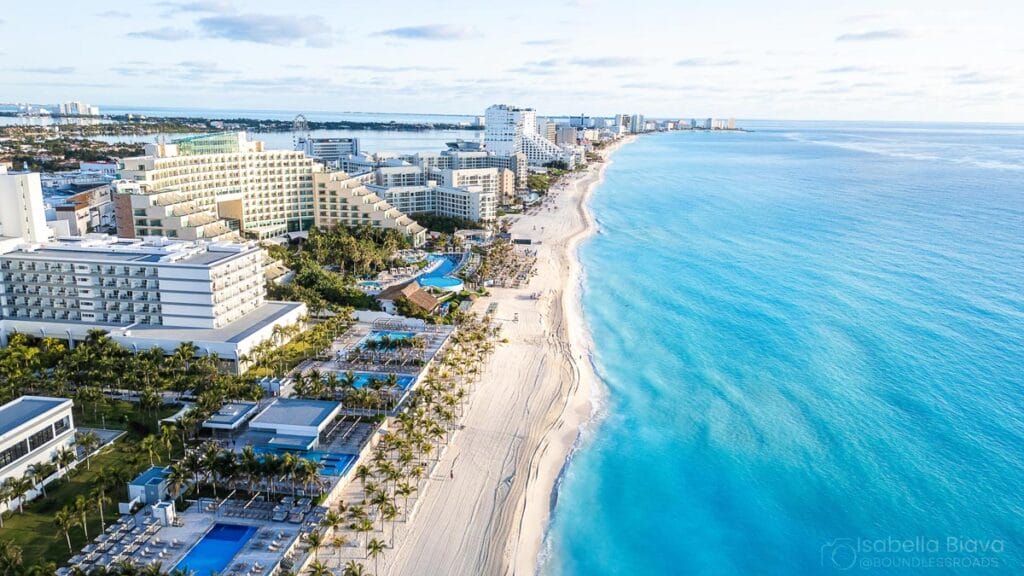
📍Best Places to Visit in Quintana Roo
Quintana Roo has a mix of famous hotspots and quieter gems. Some are great for nightlife and resorts, others for nature and local vibes. Here’s a breakdown of the places worth adding to your itinerary:
Cancún
This is the entry point for most travelers. Big resorts, wild nightlife, and easy beach access. The Hotel Zone is where all the action is, but downtown (El Centro) has more of a local feel. Don’t skip the Cancun Underwater Museum or a day trip to Isla Mujeres.
Playa del Carmen
A little more chill than Cancún but still full of energy. Quinta Avenida (5th Ave) is the main street with shops, cafes, and street performers. It’s a good base for cenote-hopping, day trips to Cozumel, or just beach lounging.
Tulum
Trendy and eco-friendly, with beachfront hotels, yoga studios, and jungle vibes. The Mayan ruins by the sea are iconic, and the beaches here are some of the prettiest around.
Tulum has been one of the most popular spots for hipsters, yogis, artists, and fashionistas, which caused a huge increase in prices in the past. It’s now much more affordable due to the high competition for rentals and hotels.
You can check out my Tulum Itinerary for more travel inspiration and detailed information. There are amazing cenotes near Tulum that you can explore, including the ones near Coba.
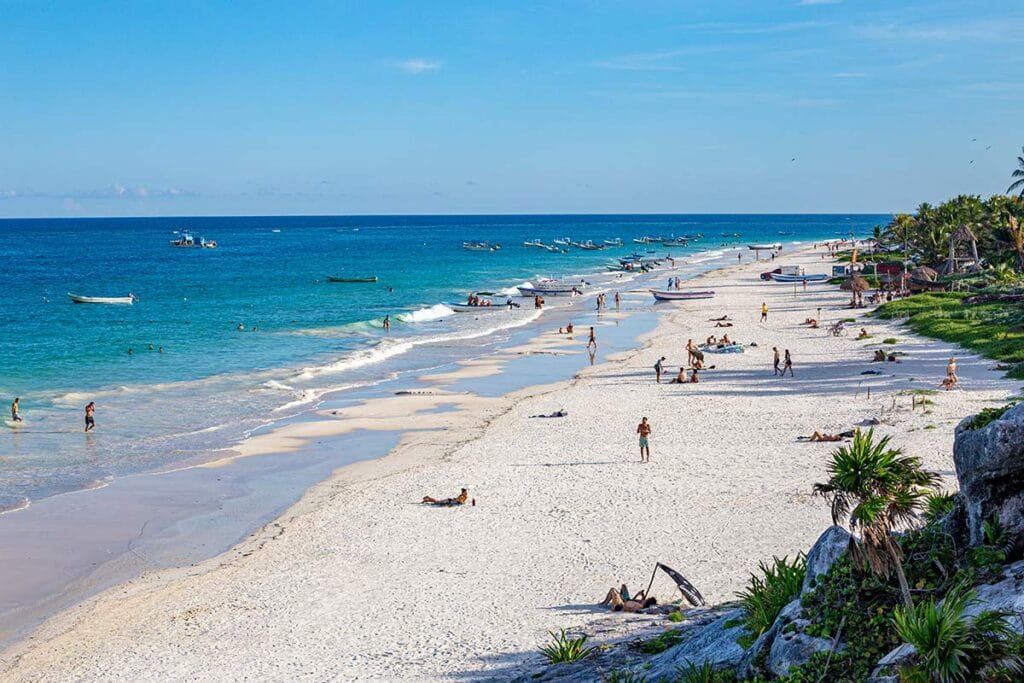
Cozumel
Best known for diving and snorkeling. If you’re into underwater adventures, this island’s reefs are top-notch. It’s quieter than the mainland and easy to explore by scooter or rental car.
Isla Mujeres
Just a quick ferry from Cancún, this little island has calm beaches, clear water, and a laid-back feel. Rent a golf cart and drive around the island, stop at the turtle sanctuary, or just chill at Playa Norte.

Holbox
No cars, sandy streets, and that remote island feel. Holbox is all about relaxing, watching sunsets, and—if you’re here at the right time—swimming with whale sharks or catching the bioluminescence at night.
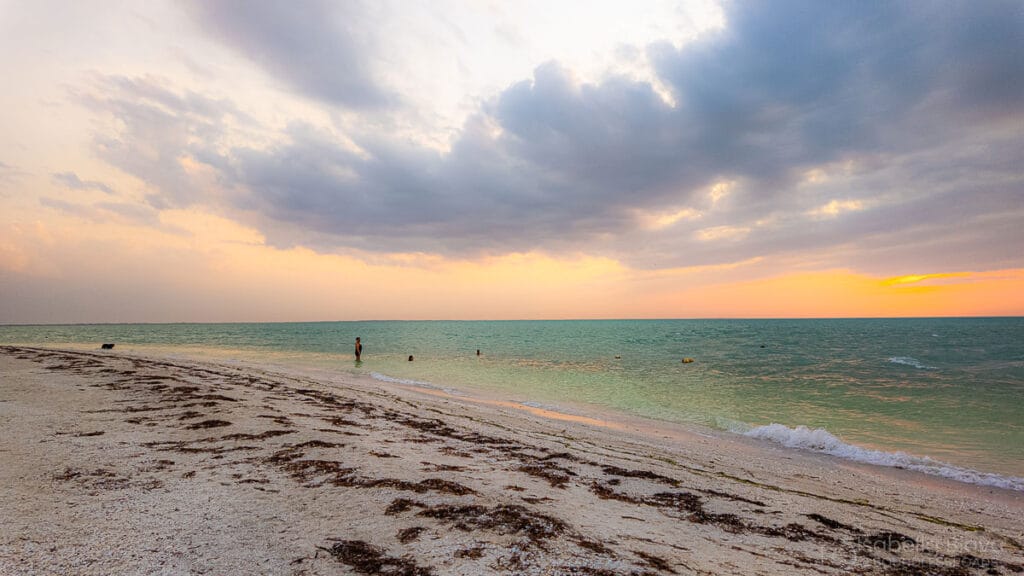
Bacalar
One of my favorite spots. The Lagoon of Seven Colors really lives up to the name. It’s peaceful, great for kayaking, and perfect for a break from the tourist crowds. It’s located at 3-hour drive from Tulum.
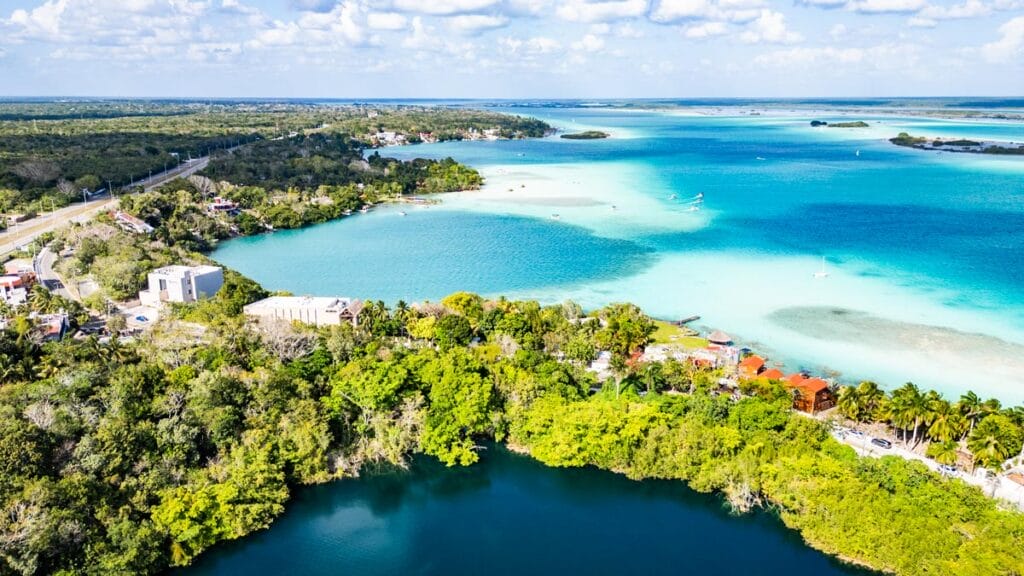
Off-the-Radar Spots
- Akumal – known for snorkeling with turtles –
- Mahahual – beach town with access to Banco Chinchorro for diving
- Xpu-Ha – quiet beach near Playa del Carmen
- Felipe Carrillo Puerto – a local town with a strong Mayan culture
- Xul-Ha – a calm alternative to Bacalar

🎯 Top Things to Do in Quintana Roo
This region is packed with activities, no matter how you like to travel. You can spend your days jumping into cenotes, wandering through ancient ruins, or doing absolutely nothing on a quiet beach. Here are some of the best things to do while you’re here.
Please note that I am just giving a general overview of the things to do but I will be writing specific post for each section with much more detailed information.
Swim in Cenotes
Cenotes are natural freshwater sinkholes, and they’re everywhere in Quintana Roo. Some are deep and dramatic, others are open and perfect for floating around. A few favorites:
- Cenote Dos Ojos – near Tulum, great for snorkeling
- Gran Cenote – easy to access and good for beginners
- Cenote Azul – between Playa and Tulum, nice for swimming with locals
Explore Mayan Ruins
You don’t have to be a history nerd to appreciate these sites.
- Tulum Ruins – right on the coast with ocean views
- Coba – Coba is one of my favorite Mayan sites in Quintana Roo. Unfortunately, you cannot climb the temple anymore, but it’s still worth a visit. In my detailed guide of Coba Ruins you will get all the information you need.
- Chichén Itzá – not in Quintana Roo technically, but close enough for a day trip
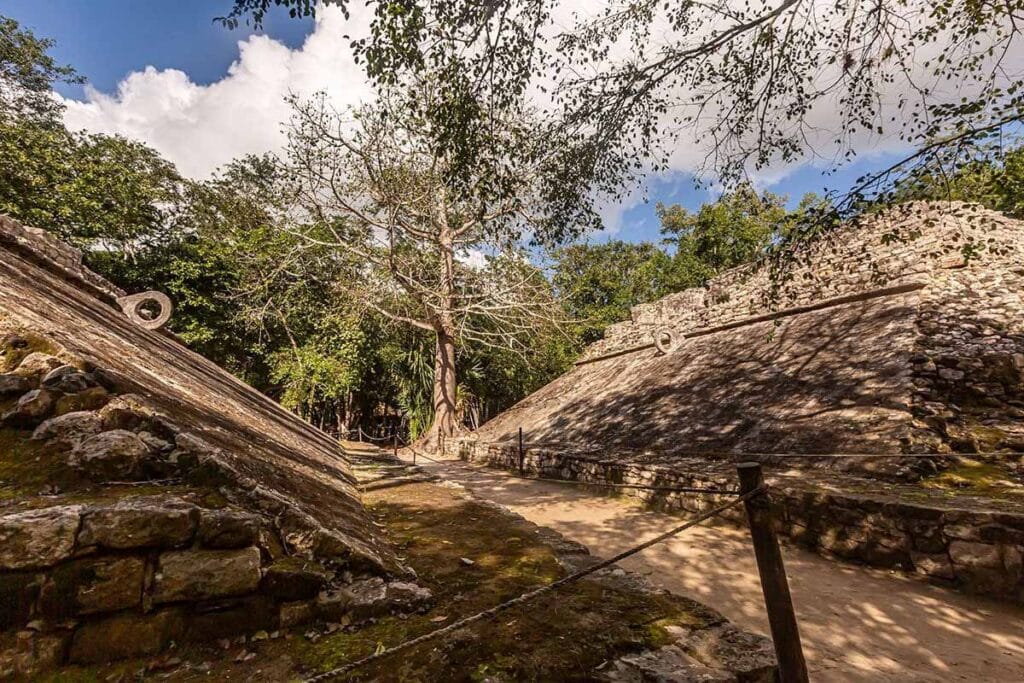
Snorkeling and Diving
The Mesoamerican Barrier Reef runs along the coast and is packed with marine life.
- Cozumel and Akumal are both great for spotting turtles and colorful fish.
- You’ll also find reef tours leaving from Playa, Tulum, and Isla Mujeres.
- Cenote diving is also very popular, but you need to be certified to do that or go with a certified instructor.
🏝️ Best Beaches in Quintana Roo
Quintana Roo has some of the most beautiful beaches in Mexico—powdery white sand, clear turquoise water, and palm trees that actually give you shade (which you’ll appreciate fast). Some beaches are built for relaxing; others are full of beach clubs and music. Here are a few standouts, but there are many more beaches, which I will discuss in a detailed post.
Playa Norte, Isla Mujeres
Calm, shallow water and soft sand make this one of the best all-around beaches. It’s perfect if you just want to float in the sea, grab a drink, and not think too hard about anything. It’s super family-friendly, too.
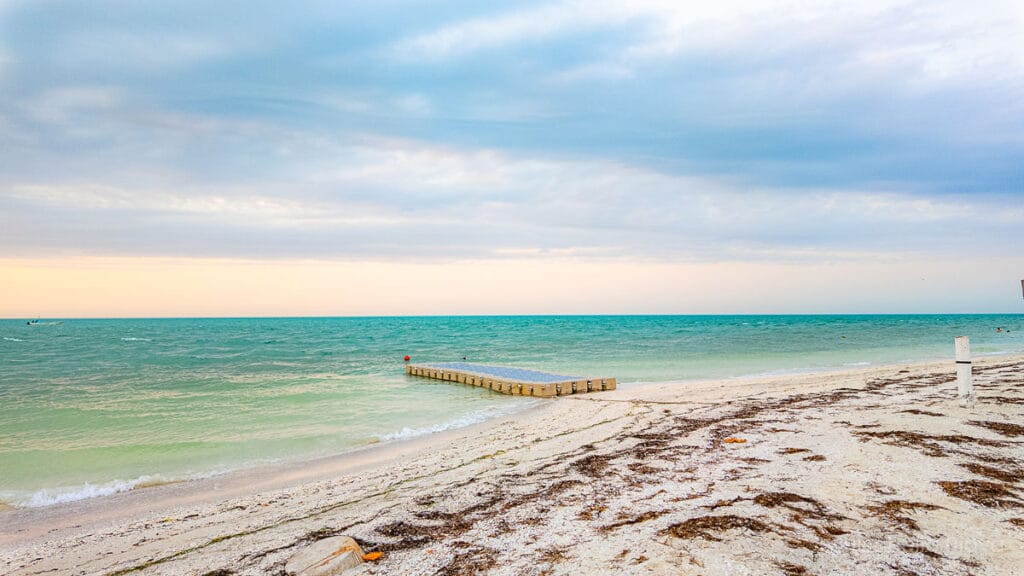
Playa Paraiso, Tulum
The name says it all. It’s the classic Tulum beach with that “dreamy Instagram” look, but it’s still totally worth a visit. You’ll find beach bars, loungers, and a mix of travelers. It’s a short walk from the ruins, so great to pair with a visit.
Xpu-Ha Beach
Halfway between Playa del Carmen and Tulum, Xpu-Ha has been one of my favorite beaches of the Riviera Maya back in the days when it was deserted and unspoiled. Now it’s a bit more crowded, but it didn’t lose its charm. Fewer crowds, just a couple of beach clubs, and plenty of space to lay your towel. Locals love it, too, which is always a good sign.
Playa Delfines, Cancún
If you’re in Cancún and want a wide-open beach with actual public access (no resort wristband required), this is it. There’s a big “Cancún” sign here for photos, and the waves are strong, so good for body surfing—but maybe not ideal for small kids.
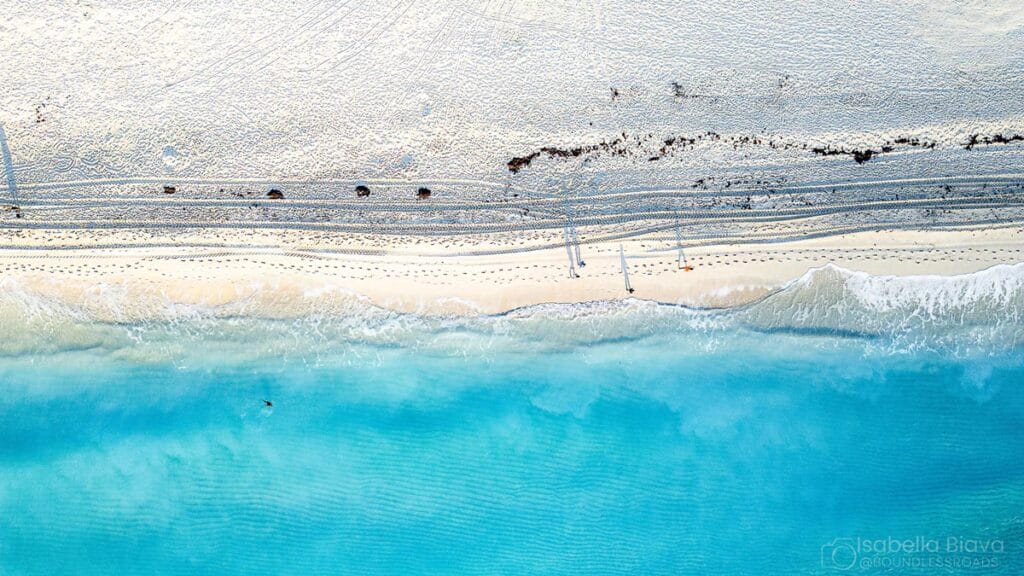
Punta Maroma
Punta Maroma one’s a bit more upscale, as it’s lined with boutique hotels and private resorts, but the beach itself is stunning. Calm water, clean sand, and just a super peaceful vibe. You’ll usually need to access it through a beach club or hotel.
Mahahual
This beach town has mellow vibes and shallow, swimmable water. It’s also the jumping-off point for snorkeling trips to Banco Chinchorro. The malecón (boardwalk) is lined with small bars and hammocks, so you can beach-hop with a drink in hand.
Holbox Beaches
Holbox is one of those rare islands that still feels like a secret. Sitting off the northern tip of the Yucatán Peninsula, this car-free island is part of the Yum Balam Nature Reserve, where streets are made of sand and golf carts replace cars. It’s best known for its laid-back vibe, colorful murals, and crystal-clear turquoise waters that look unreal.
What makes Holbox special is how untouched it feels—you’ll spot flamingos, pelicans, and, if you’re lucky, swim alongside whale sharks from June to September. The sunsets here are incredible, and the bioluminescent plankton at night is pure magic.
Visitors come to relax in hammocks suspended over the sea, sip fresh coconuts, and wander barefoot through town, where local restaurants serve ceviche and lobster pizza. There’s no big nightlife or crowds—just the sound of waves, music drifting from beach bars, and the occasional golf cart whizzing by.
Holbox is the kind of place where time slows down and simplicity feels luxurious. It’s perfect if you’re craving a break from busy resorts and want to experience a slice of authentic island life in Mexico.
Adventure Activities
If you’re up for more action:
- Zip-lining and underground rivers at Xplor Park
- Kayaking in Bacalar Lagoon
- Jungle hikes in Punta Laguna
- Paddleboarding and kite surfing in Holbox

Cultural Experiences
- Join a local cooking class or temazcal (Mayan sweat lodge) ceremony
- Visit a small town like Felipe Carrillo Puerto to see modern Maya culture in real life
- Stop by a traditional market to shop for crafts and try local snacks
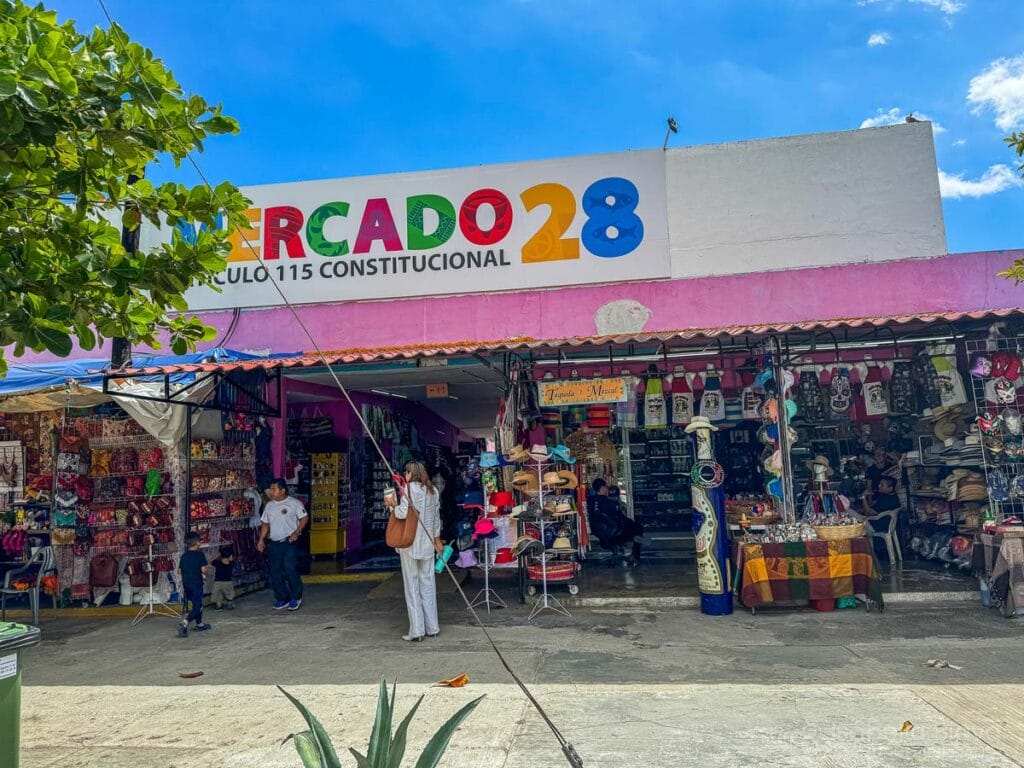
🌮 Food & Local Culture in Quintana Roo
If you’re like me and believe that half the reason to travel is to eat—welcome. Quintana Roo has plenty of beach views and ancient ruins, but the food and culture are just as memorable. You’ll find a mix of traditional Yucatecan dishes, Mexican street snacks, fresh seafood, and some international influence in the more touristy towns.
🥘 Must-Try Local Dishes
- Cochinita Pibil – Slow-roasted pork marinated in citrus and achiote, usually served with pickled red onions. Classic Yucatán dish that you will find in Quintana Roo as well
- Tacos al Pastor – Spit-roasted pork with pineapple, usually from a street cart. Cheap and delicious.
- Panuchos & Salbutes – Fried tortillas stuffed or topped with beans, meat, and veggies. A local snack favorite.
- Ceviche – Super fresh here, made with fish or shrimp “cooked” in lime juice. Perfect for beach days. This is a typical dish that you can find in meny coastal towns of Mexico.
- Marquesitas – Crispy rolled crepes filled with Nutella, cheese, or both. Popular at night markets.
🥤 Drinks to Try
- Agua de Chaya – A refreshing green drink made from local chaya leaves (kind of like spinach but tastier).
- Horchata – Sweet rice drink with cinnamon—especially good on a hot day.
- Micheladas – Beer mixed with lime juice, sauces, and spices. Like a spicy beer cocktail.
- Mezcal & Tequila – Available everywhere, but local bars often serve artisanal brands you won’t find back home.
🛍️ Markets & Local Life
Skip the big souvenir stores and hit the mercados. You’ll find handmade hammocks, embroidered textiles, pottery, and wooden crafts that actually make good keepsakes.
- Mercado 28 (Cancún) – Great for haggling and picking up colorful crafts.
- Tulum’s Handicraft Shops – A little pricier, but the quality and design are top-notch.
- Local Mayan Villages – If you get the chance to visit one, many sell handmade goods directly. It’s a great way to support the community. You can find a lot around Calakmul.
🙋♂️ Culture Tip
People here are friendly, and even a little Spanish goes a long way. A quick “buenos días” or “gracias” is always appreciated. In smaller towns, you might hear some Mayan language spoken too—it’s still part of daily life for many families.
🌿 Outdoor & Nature Experiences in Quintana Roo
One of the best things about Quintana Roo is how easy it is to step right into nature. You don’t have to go far to find jungles, lagoons, wildlife, or reef-filled waters. Whether you’re into chill outdoor time or full-on adventure mode, this region has options.
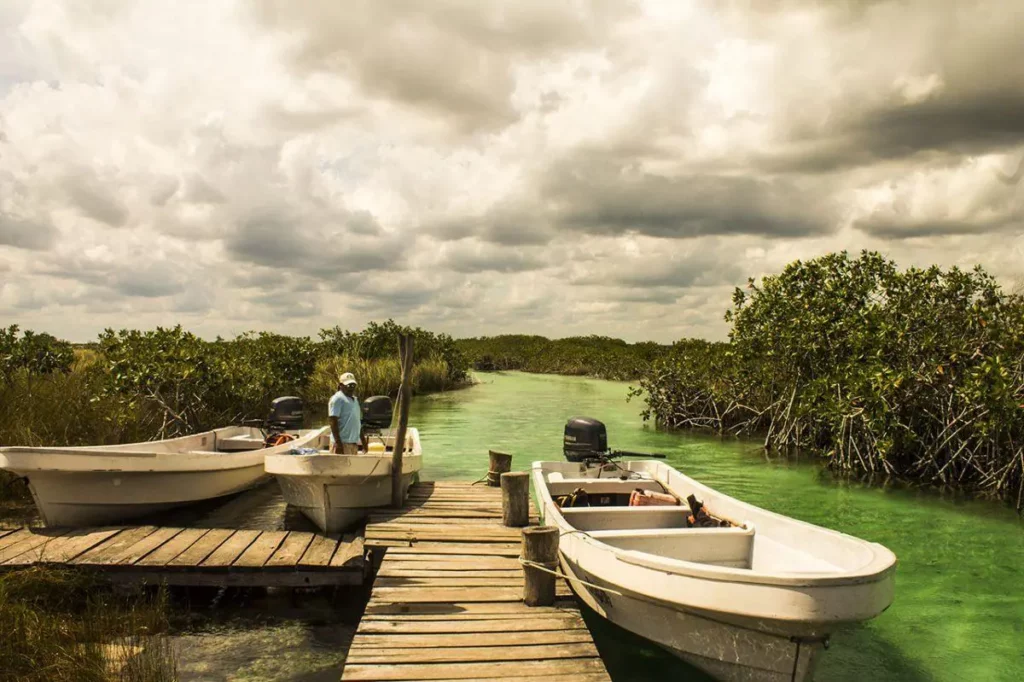
🐠 Snorkeling & Diving
The Mesoamerican Barrier Reef runs along the coast, so the underwater life is seriously impressive.
- Cozumel has world-class dive sites like Palancar Reef.
- Akumal is perfect for snorkeling with sea turtles (bring your own mask if you have one).
- Puerto Morelos is underrated and great for quick, easy reef tours.
🥾 Jungle Hikes & Nature Reserves
- Sian Ka’an Biosphere Reserve – A UNESCO site with mangroves, lagoons, and wildlife like manatees and dolphins. Go with a guide—worth it.
- Punta Laguna – Near Cobá, this reserve has spider monkeys, zip lines, and a peaceful lake you can canoe.
- Muyil Ruins + Floating Canal Swim– A short hike leads to a stunning jungle lagoon. Add the lazy river float—perfect for relaxation. I’ll tell you all about my adventure in Muyil in a dedicated post.
🛶 Kayaking & Paddleboarding
- Bacalar Lagoon is the top spot. Paddle through the different shades of blue and stop at cenotes along the shore.
- You can also kayak in Holbox’s mangroves, which is great for spotting birds and maybe even flamingos.
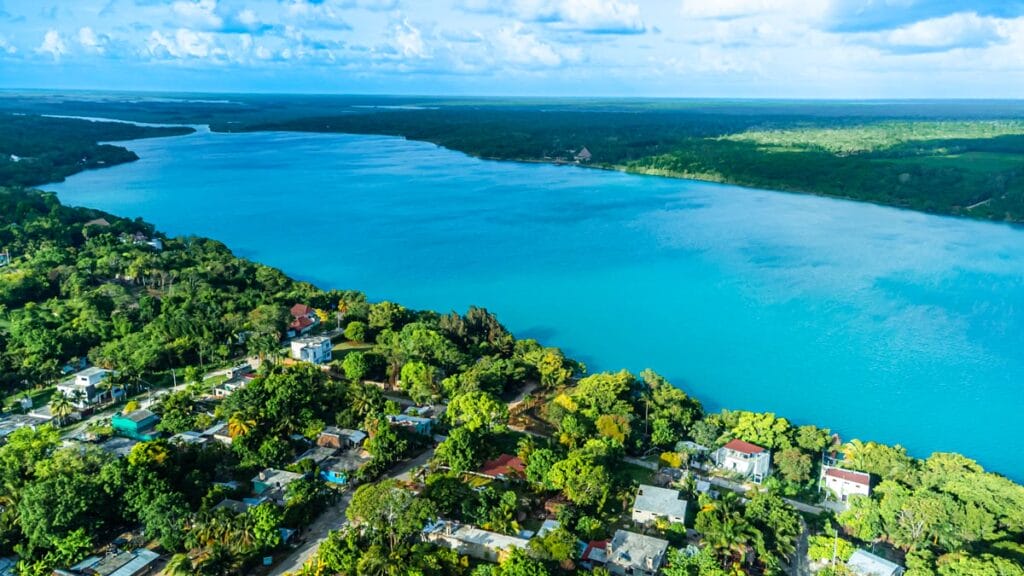
🦜 Wildlife Watching
Bring binoculars if you’re into wildlife—this area’s got tropical birds, monkeys, crocodiles, and more.
- Best spots: Sian Ka’an, and even early mornings in Xul-Ha or around Felipe Carrillo Puerto.
🌌 Nighttime Nature
- Bioluminescence in Holbox – You can see the glowing plankton best on dark, moonless nights—book a kayak tour for the full effect.
- Turtle nesting season (May to October) – Some beaches near Akumal and Xcacel-Xcacelito offer guided releases and observation experiences.
📅 Best Time to Visit Quintana Roo
Quintana Roo has a tropical climate, so it’s warm year-round—but that doesn’t mean every month is the same. Some seasons are better for sunshine and calm seas, others are quieter (and cheaper), and then there’s hurricane season, which you’ll want to plan around.
☀️ November to April: Dry Season & Peak Travel Time
This is the best time to visit if you want sunny days, low humidity, and clear water. It’s also the busiest season, especially around Christmas, New Year’s, and Spring Break. Expect higher prices and more crowds—but the weather is ideal.
- Great for beach days, snorkeling, and exploring ruins.
- Best visibility for diving and reef tours.
- Book hotels and tours early if you’re coming during the holidays.
🌧️ May to October: Rainy Season & Low Season
It’s hotter, more humid, and you’ll probably get afternoon rain. But prices drop, and popular places are way less crowded. Just keep in mind this is also hurricane season (especially August to October), so be flexible with plans.
- Good time for deals on hotels and flights.
- Whale shark season (June to September) in Isla Holbox.
- Sargassum (seaweed) can show up on beaches—some spots are worse than others.
🎉 Local Events & Festivals to Consider
- Carnaval (Feb/March) – Big in Cozumel and Mahahual
- Day of the Dead (Nov 1–2) – Cultural altars and events across the region
- Riviera Maya Jazz Festival (Nov) – Free concerts in Playa del Carmen
- Turtle nesting season (May–Oct) – Great for eco tours in Akumal and Xcacel
🏨 Where to Stay in Quintana Roo
There’s no shortage of places to stay in Quintana Roo—from all-inclusive resorts to jungle cabanas and beachfront hostels. It really depends on your style, budget, and how close (or far) you want to be from the crowds.
💎 Luxury Resorts
If you’re looking for pampering, private beach access, and spa days, Quintana Roo has some seriously beautiful resorts. Many are in gated areas like Mayakoba or along the Riviera Maya.
Top picks:
- Nizuc Resort & Spa (Cancún)
- Rosewood Mayakoba (near Playa del Carmen)
- Casa Malca (Tulum – artsy and dramatic)
🏝️ Boutique Hotels
Small, stylish, and full of character. These are perfect if you want something unique but still comfortable. Expect great decor, local design touches, and a more personal experience.
Favorites:
- La Zebra (Tulum)
- Hotel Secreto (Isla Mujeres)
- Habitas (Tulum – eco-chic with a view)
💰 Budget-Friendly Options
Hostels, guesthouses, and low-key hotels are easy to find, especially in places like Tulum town, Playa del Carmen, and downtown Cancún. Many offer shared kitchens, rooftop bars, or co-working spaces.
Solid options:
- Selina (Cancún and Tulum – great for digital nomads)
- Weary Traveler Hostel (Tulum)
- Hotel Posada 06 (Playa – clean, affordable, close to the action)
🍃 Eco-Lodges & Unique Stays
If you want to stay closer to nature, eco-lodges and off-grid cabins are a great choice. Some are deep in the jungle, others are beachfront with solar power and compost toilets. These often come with yoga classes, organic meals, and amazing views.
Try these:
- Azulik (Tulum – for the full jungle-meets-design experience)
- Casa Kaan (Bacalar – peaceful and surrounded by greenery)
- Holbox Dream Beachfront (Holbox – laid-back and steps from the sea)
🚗 Getting Around Quintana Roo
Getting from place to place in Quintana Roo is pretty easy once you get the hang of it. Distances can be longer than they look on a map, so it’s good to plan ahead depending on your style of travel.
🚘 Renting a Car
If you want total flexibility, renting a car is the way to go—especially for exploring cenotes, small towns, and off-the-beaten-path beaches. Roads are generally in good shape. Just watch out for speed bumps (they’re everywhere).
- Book ahead, especially during high season.
- Most rentals require a credit card and basic insurance.
- Gas stations are full-service—someone will pump it for you.
🚌 Buses & Colectivos
Buses (like ADO) are great for getting between cities. They’re cheap, comfortable, and have A/C.
Colectivos (shared vans) are perfect for short rides between towns—like Playa to Tulum or Tulum to Akumal. Just flag one down and pay in cash.
🚕 Taxis
Taxis are everywhere, but always ask the price before you get in—there are no meters. In Cancun and Playa, prices are higher. Try to get a ballpark idea from your hotel or ask a local.
🚲 Bikes & Scooters
Tulum, Holbox, and Isla Mujeres are super bike-friendly. You can rent one for a few bucks a day. In Tulum, it’s the easiest way to get from the beach to town. On Cozumel or Isla Mujeres, scooters are a fun option.
🧳 Practical Travel Tips for Quintana Roo
A few things that will make your trip smoother, especially if it’s your first time here:
💵 Money
- The local currency is the Mexican Peso.
- Most places accept cards, but small businesses, colectivos, and markets are cash only.
- ATMs in tourist zones are convenient, but bank ATMs (like Santander or BBVA) have better rates and fewer issues.
🌡️ Weather & What to Pack
- It’s hot and humid most of the year—light, breathable clothing is key.
- Bring reef-safe sunscreen, insect repellent, and a reusable water bottle.
- Water shoes are great for cenotes.
- A light rain jacket helps during the summer.
📱 Connectivity
- Wi-Fi is available in most hotels and cafes, but can be spotty in remote areas.
- You can buy a local SIM card (Telcel or AT&T) for cheap data if you’re staying a while.
- Some beach towns like Holbox may have limited service, so download maps offline.
🔐 Safety
- Quintana Roo is generally safe for travelers, but stay alert like anywhere else.
- Avoid walking alone late at night on empty streets or beaches.
- Don’t flash cash or valuables.
- Use only official taxis or rideshare apps where available.
🧼 Health
- Don’t drink tap water. Stick to bottled or filtered.
- Stay hydrated and pace yourself in the heat.
- Bring basic meds (like something for stomach issues)—local pharmacies are good but don’t always carry familiar brands.
🗓️ Sample Itineraries for Quintana Roo
Need help figuring out how to organize your trip? Here are a few easy itineraries based on how much time you’ve got and what kind of experience you’re after.
✨ 3-Day Itinerary: Quick Highlights
Base: Cancún or Playa del Carmen
- Day 1: Beach time in Cancún, ferry to Isla Mujeres for sunset and dinner
- Day 2: Day trip to Tulum – visit ruins and swim at Playa Paraiso
- Day 3: Swim in a cenote (Gran Cenote or Cenote Azul) and explore downtown Playa
🧳 5-Day Itinerary: Classic Mix
Base: Split between Playa del Carmen & Tulum
- Day 1: Arrive in Playa, stroll Quinta Avenida
- Day 2: Ferry to Cozumel for snorkeling
- Day 3: Head to Tulum, explore the ruins
- Day 4: Visit cenotes + chill at the beach
- Day 5: Optional trip to Cobá or Sian Ka’an
🌿 7-Day Itinerary: Nature + Culture
Base: Combo of Cancún, Tulum, Bacalar
- Day 1: Arrive in Cancún, relax
- Day 2: Visit Isla Mujeres or spend the day at Xcaret
- Day 3–4: Head to Tulum, explore ruins + cenotes
- Day 5–6: Bacalar – kayak the lagoon, visit Fort San Felipe
- Day 7: Back to Cancún or head south to Mahahual if you want more beach time
You can mix and match depending on your interests—want help personalizing an itinerary? Just ask.
❓ Frequently Asked Questions About Quintana Roo
Here’s a quick-hit FAQ section for the stuff people always wonder about:
Is Quintana Roo safe to visit?
Yes, especially in tourist areas. Use common sense, avoid sketchy situations at night, and stick to legit transportation.
Do I need a visa to visit?
If you’re from the U.S., Canada, EU, or most of Latin America, you can enter visa-free for up to 180 days. Just bring a passport valid for at least 6 months. However, it’s up to the immigration agent to give you as many days as they want when you arrive. You can check it on the stamp they made on your passport.
Can I drink the tap water?
Nope. Stick to bottled or filtered water—even for brushing your teeth if your stomach is sensitive. I recommend Water-to-go filter bottle to clean any type of water so you will never be thirsty or dehydrated.


WATER-TO-GO FILTER BOTTLE
✔ kills 99.99% of bacteria of all sorts, illness-causing contaminants, including those as small as a virus, pesticides and nitrates, heavy metals…
✔ available in different shapes, sizes and colors
✔ easy to use
✔ three-month shelf life in total
✔ Better protection for you and the planet. The filter replaces 400 plastic bottles, and the bottle is made from sugarcane.
When is the best time to go?
November to April is the driest and most comfortable. May to October is hotter, cheaper, and has more rain (plus possible sargassum and hurricanes).
What’s the best way to get around?
Rent a car if you want flexibility. Otherwise, buses, colectivos, and ferries are reliable and cheap. Taxis are fine if you agree on a price first.
Where should I go if I want fewer crowds?
Skip the Hotel Zone and check out Bacalar, Holbox, Xpu-Ha, or Mahahual. Even parts of Tulum and Cozumel are still relatively quiet.
What’s the deal with sargassum (seaweed)?
It shows up mostly between May and September and affects some beaches more than others. Bacalar, Cozumel’s west coast, and some eco-resorts maintain their beaches well.
🌅 Final Thoughts on Visiting Quintana Roo
Quintana Roo is one of those places that sticks with you—whether it’s the color of the water, the cenotes hidden in the jungle, or the smell of tacos grilling on the street. There’s a reason this part of the Yucatán Peninsula is one of the most visited areas in Mexico. But beyond the big names like Cancún and Tulum, there’s so much more to see, especially if you take the time to slow down and explore the quieter corners.
I’ve lived here since 2010, and I’m still discovering new favorite beaches, family-run eateries, and local spots that don’t show up on most travel lists. Hopefully, this guide gave you everything you need to plan your trip—and a few ideas you hadn’t thought of yet.
If you have questions, want help fine-tuning your route, or just want personal tips, feel free to reach out. Safe travels—and enjoy every minute of your time in Quintana Roo!


